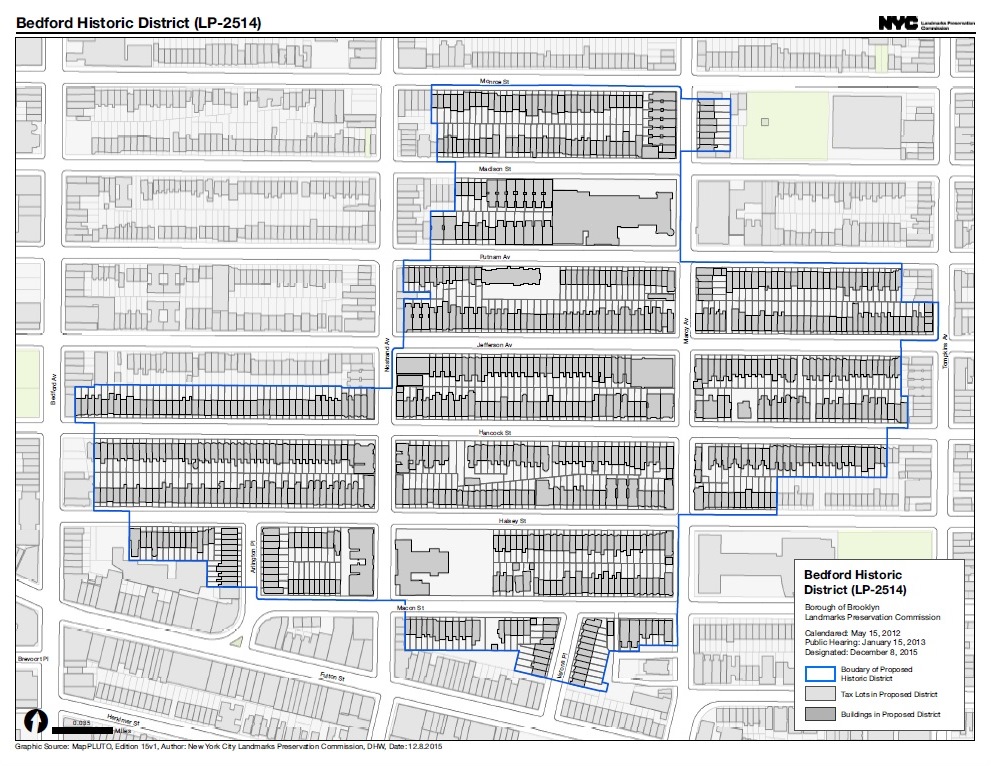

Map of the approved Bedford Historic District. Image credit: LPC
Approximately 800-building district is primarily characterized by residential architecture from the late 19th century. On December 8 2015, the Landmarks Preservation Commission voted to designate the Bedford Historic District, composed of approximately 800 buildings and roughly bounded by Bedford, Nostrand, Putnam, Tompkins and Marcy Avenues, and Monroe, Fulton, and Halsey Streets in the Bedford-Stuyvesant neighborhood of Brooklyn. The area mostly consists of residential buildings constructed between 1870 and 1900, both rowhouses and small apartment buildings, in a variety of the typical styles of the area, including Queen Anne, Italianate, neo-Grec, and Renaissance Revival. Landmarks’ Research Department called the district a “remarkably well-preserved section of Bedford-Stuyvesant.”
The initial inhabitants of the district were largely composed of New Englanders who recently arrived to Brooklyn, as well as German and Irish immigrants. During World War I, the area began to attract a significant African-American population, drawn by high-quality housing stock and their inability to acquire property in other sections of the City. In the 1920s and 1930s, the neighborhood became one of the focal points of Black cultural life, along with Harlem, in the City.
Landmarks held a hearing on the district’s potential designation on January 15, 2013. At the hearing, the overwhelming majority of speakers testified in support of designation. Residents and members of community organizations spoke of the out-of-scale development endangering the community’s historic architecture, and the many celebrated people who had called the area home. Numerous preservationist organizations spoke to endorse designation, as did then Council member Albert Vann and a representative of then Borough President Marty Markowitz.
Some local property owners opposed designation, as did the pastor of St. Paul Community Church and Mt. Pisgah Baptist Church, Johnny Ray Youngblood. Youngblood and others opposed the financial constraints they said landmarking would impose on property owners, and argued that there had not been sufficient outreach to the community.
Landmarks research department reviewed the boundaries in the light of public testimony, and recommended that the district not be modified.
Commissioner Fred Bland found the district eminently worthy of landmark designation, saying it was “really a museum of late-19th-century architecture in New York,” and that it was “hard to believe it took this long” to gain official recognition. Commissioner John Gustafsson praised the “purity” of the historic streetscapes, and said that the district was “the definition of why we are doing what we are doing.” Chair Meenakshi Srinivasan acknowledged the neighborhood’s importance in the social history of New York and the nation, and stated that the “cultural layer is as important as it architectural merits.” Srinivasan also thanked the community members who had worked to ensure the neighborhood’s preservation.
Commissioners voted in unanimously in favor of designation. The vote was greeted with cheers from assembled Bedford residents and preservationists.
LPC: Bedford Historic District, Brooklyn (LP-2514) (Dec. 8, 2015).
By: Jesse Denno (Jesse is a full-time staff writer at the Center for NYC Law)
